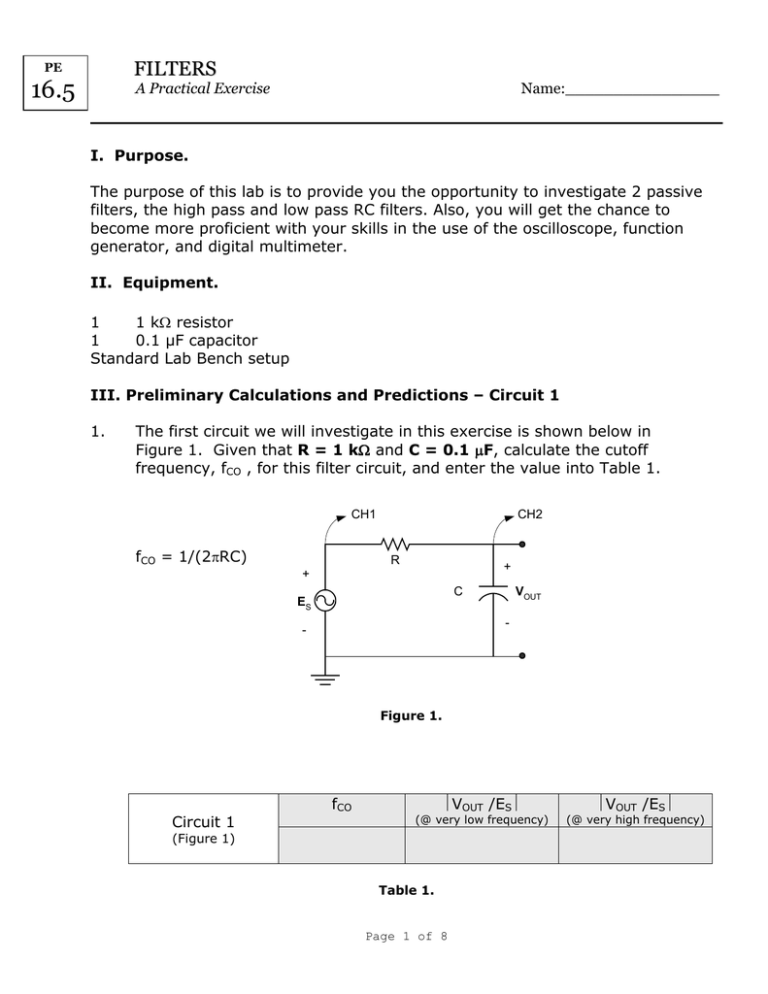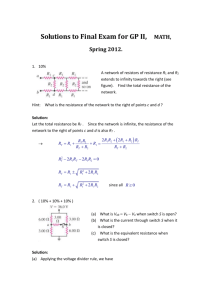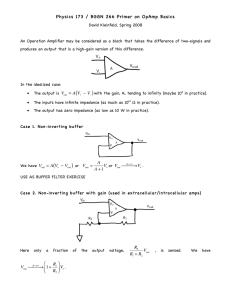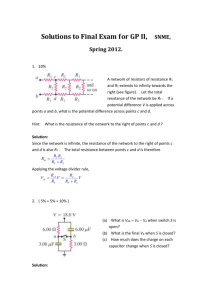16.5 F I
advertisement

FILTERS PE 16.5 A Practical Exercise Name:________________ I. Purpose. The purpose of this lab is to provide you the opportunity to investigate 2 passive filters, the high pass and low pass RC filters. Also, you will get the chance to become more proficient with your skills in the use of the oscilloscope, function generator, and digital multimeter. II. Equipment. 1 1 kΩ resistor 1 0.1 µF capacitor Standard Lab Bench setup III. Preliminary Calculations and Predictions – Circuit 1 1. The first circuit we will investigate in this exercise is shown below in Figure 1. Given that R = 1 kΩ and C = 0.1 µF, calculate the cutoff frequency, fCO , for this filter circuit, and enter the value into Table 1. CH1 fCO = 1/(2πRC) CH2 R + + C ES VOUT - - Figure 1. Circuit 1 fCO VOUT /ES (@ very low frequency) (Figure 1) Table 1. Page 1 of 8 VOUT /ES (@ very high frequency) 2. The impedance of a capacitor, ZC, varies inversely with frequency so that, at low frequencies, ZC will be a relatively high value, and at high frequencies, ZC will be a relatively low value. From this information and your knowledge of the operation of a voltage divider, what do you expect the value of the ratio |VOUT /ES| to be for the circuit above, at both a very low frequency and at a very high frequency? Enter the approximate values (either 0 or 1) you anticipate into Table 1 above. 3. The magnitude of the ratio of VOUT to ES , i.e., |VOUT/ES|, for the circuit of Figure 1, is plotted in dB in Graph 1 below. You may recall from EE301 that the analysis of the voltage divider circuit gives the following result for this value: Vout = Es 1 ωC 1 R + ωC 2 [remember that ω = 2πf] 2 and, |VOUT / ES|dB = 20 log10 |VOUT / ES| Determine the value of |VOUT / ES|dB at the cutoff frequency, fCO , you calculated in Step 1 and plot this value in Graph 1 using a small circle. Page 2 of 8 4. The circuit in Figure 1 can be classified as what type of filter? Magnitude in dB High Pass Low Pass Band Pass (Circle one) 5 0 -5 -10 -15 -20 -25 -30 -35 -40 2 10 3 4 10 10 5 Frequency in Hz 10 Graph 1. - Plot for Circuit 1 (in Figure 1) IV. Preliminary Calculations and Predictions – Circuit 2 5. The next circuit we will investigate in this exercise is shown below in Figure 2. Given that R = 1 kΩ and C = 0.1 µF, calculate the cutoff frequency, fCO , for this filter circuit, and enter the value into Table 2. CH1 fCO = 1/(2πRC) + CH2 C + VOUT R ES - - Figure 2. Page 3 of 8 fCO Circuit 2 VOUT/ES (@ very low frequency) VOUT/ES (@ very high frequency) (Figure 2) Table 2. 6. The impedance of a capacitor, ZC, varies inversely with frequency so that, at low frequencies, ZC will be a relatively high value, and at high frequencies, ZC will be a relatively low value. From this information and your knowledge of the operation of a voltage divider, what do you expect the value of the ratio |VOUT /ES| to be for the circuit above, at both a very low frequency and at a very high frequency? Enter the approximate values (either 0 or 1) you anticipate into Table 2 above. 7. The magnitude of the ratio of VOUT to ES , i.e., |VOUT/ES|, for the circuit of Figure 2, is plotted in dB in Graph 2 below. An analysis of the voltage divider circuit gives the following result for this value: Vout = Es R 1 R2 + ωC 2 [remember that ω = 2πf] and, |VOUT / ES|dB = 20 log10 |VOUT / ES| Determine the value of |VOUT / ES|dB at the cutoff frequency, fCO , you calculated in Step 5 and plot this value in Graph 2 using a small circle. Page 4 of 8 8. The circuit in Figure 2 can be classified as what type of filter? Magnitude in dB High Pass Low Pass Band Pass [circle one] 5 0 -5 -10 -15 -20 -25 2 10 10 3 10 4 Frequency in Hz 10 5 Graph 2 - Plot for Circuit 2 (in Figure 2) V. Measurements – Circuit 1 1. 2. Construct the circuit of Figure 1 on your quad board. Make the connections to Channel 1 and Channel 2 of the oscilloscope as shown. Don’t forget to connect a wire from the ground of your circuit to the ground of the o-scope. Turn on the o-scope and the function generator. Adjust the generator to provide 1 Vrms at 100 Hz. Use the DMM to adjust the AC voltage to 1 V because it measures in rms directly. (You will need to push the AC-V button on the DMM). The o-scope will be used to observe the amplitudes and relative phases of the source voltage, ES, and the capacitor voltage, VOUT, simultaneously. Use the MEASURE button to display rms amplitudes and the period, and use the cursors to display the time delay. Calculate the phase delay using: ∆φ = ∆t × 360° / T where, ∆φ = phase delay ∆t = time delay T = period ∆φ = ____________ (Include +/- for leading or lagging.) Page 5 of 8 Enter the phase angle found at this frequency into Table 3. 3. Use a second DMM to measure the output voltage, VOUT, across the capacitor. Enter this value into Table 3 (f = 100Hz). The input amplitude should be 1 Vrms. 4. Repeat Steps 2 and 3 for input frequencies of 1.59 kHz and 20 kHz. Dialing these subsequent frequencies on the function generator – as opposed to entering them using the pushbuttons – allows you to observe the changing relationship (both magnitude and phase) between the two sinusoidal waveforms on the o-scope as the frequency is changed. You will need to adjust your horizontal and vertical scales of the o-scope as you increase the frequency of your input signal. Make sure the input amplitude remains at 1 Vrms when you are at 1.59 kHz and 20 kHz. 5. Complete Table 3 by doing the necessary calculations to find |VOUT/Es| and the magnitude in dB of the ratio |VOUT/Es|. Frequency VOUT (rms) |VOUT/Es| |VOUT/ES| in dB Angle, ∆φ 100 Hz 1.59 kHz 20 kHz Table 3. VI. Measurements – Circuit 2 6. Turn off the generator and construct the circuit in Figure 2 by switching the positions of the capacitor and the resistor in your circuit, leaving all other connections in place. 7. Turn on the function generator. Adjust the generator to provide 1 Vrms at 20 kHz. Use the DMM to adjust the AC voltage to 1 V because it measures in rms directly. (You will need to push the AC-V button on the DMM). The o-scope will be used to observe the amplitudes and relative phases of the source voltage, ES, and the resistor voltage, VOUT, simultaneously. Use the MEASURE button to display rms amplitudes and the period, and use the cursors to display the time delay. Calculate the phase delay using: ∆φ = ∆t × 360° / T where, Page 6 of 8 ∆φ = phase delay ∆t = time delay ∆φ = ____________ (Include +/- for leading or lagging.) T = period Enter the phase angle found at this frequency into Table 4. 8. Use a second DMM to measure the output voltage, VOUT, across the resistor. Enter this value into Table 4. (f = 20 kHz). The input amplitude should be 1 Vrms. 9. Repeat Steps 7 and 8 for input frequencies of 1.59 kHz and 100 Hz. Make sure the input amplitude remains at 1 Vrms when you are at 1.59 kHz and 100 Hz. 10. Complete Table 4 by doing the necessary calculations to find |VOUT/Es| and the magnitude in dB of the ratio |VOUT/Es|. Frequency VOUT (rms) |VOUT/Es| |VOUT/ES| in dB Angle, ∆φ 100 Hz 1.59kHz 20 kHz Table 4. VII. Questions and Observations The cutoff frequency of a filter, fco, is usually considered to be the point at which frequencies change from passing through the filter to not passing through the filter. (Frequencies not passing through a filter are said to be rejected by the filter). A. For the circuit of Figure 1: what range of frequencies would pass through the filter: __________Hz to __________Hz what range of frequencies would not pass through the filter: __________Hz to __________Hz B. For the circuit of Figure 2: what range of frequencies would pass through the filter: __________Hz to __________Hz Page 7 of 8 Use: “0 Hz” for very low frequency & “∞ Hz” for very high frequency what range of frequencies would not pass through the filter: __________Hz to __________Hz C. Compare the values you calculated and entered into Table 3 for “|VOUT/ES| in dB” with the theoretical values depicted in Graph 1: Frequency 100 Hz |VOUT/ES| in dB (from Table 3) |VOUT/ES| (from Graph 1) 1.59kHz 20 kHz D. Compare the values you calculated and entered into Table 4 for “|VOUT/ES| in dB” with the theoretical values depicted in Graph 2: Frequency 100 Hz |VOUT/ES| in dB (from Table 4) |VOUT/ES| (from Graph 2) 1.59kHz 20 kHz Page 8 of 8







